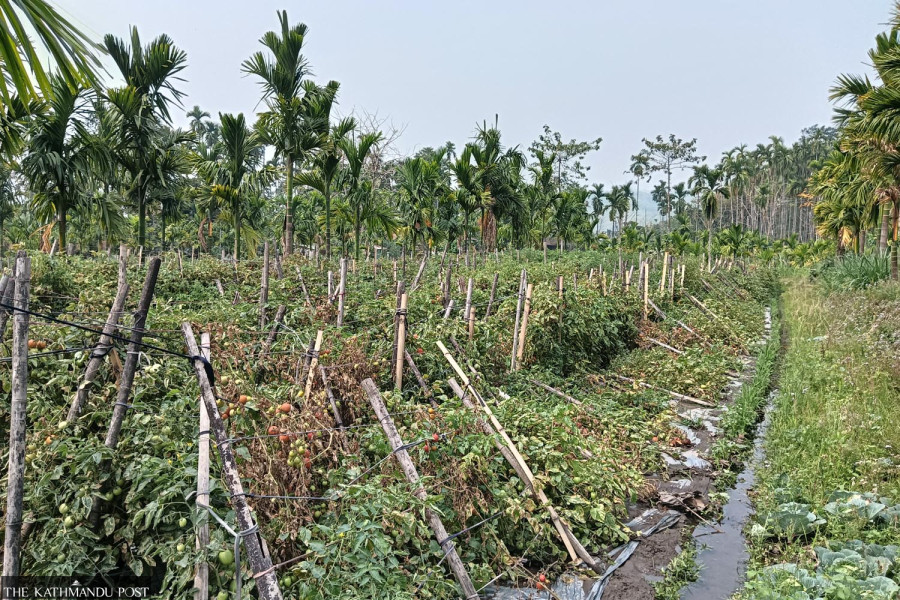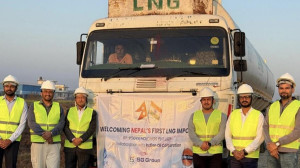Money
Tomato prices crash to Rs5 per kg amid market glut
Due to a bumper harvest, markets struggle to absorb the supply, resulting in one of the lowest prices in decades.
Navaraj Subedi
Dipesh Dangal in Mechinagar municipality produces 300 crates (of 25 kg) of tomatoes weekly on a bigha and a half. He harvests twice a week.
Engaged in agriculture since the 1990s, his neighbours and others see him as a successful farmer. But he has several untold stories. Adding all costs, including labour and transportation, his margin on a kg of tomato stands at Rs5 per kg.
"What’s the use of growing tomatoes? There is no market. No value,” said Dangal. “This time, I won’t even recover my investment."
He borrows money to pay workers to pick up and transport tomatoes. With hopes to secure his future in agriculture, he took a bank loan to start tomato farming.
Cultivating tomatoes on one-and-a-half bighas cost him around Rs600,000. However, once production started, the tomatoes did not find a market. The bank that lent him the money is pressuring him to repay it.
"The bank constantly reminds me of the loan. I fear my land might get auctioned off," he added.
The harvested tomatoes must be taken to the agricultural market in Charali or Birtamod. The transportation costs Rs50 per crate. Additionally, unloading costs Rs10 per crate, and the market charges a 10 percent commission on the sales. The cost of hiring labourers to pick the tomatoes is separate—about 20 workers are needed per week, each paid Rs500 per day.
Despite these high costs, tomatoes are sold at just Rs200–250 per crate.
“We don’t get Rs5 per kg in wholesale markets after deducting expenses. How do we repay loans? How do we pay workers?" he questioned.
While tomatoes sell for Rs25 per kg in retail markets, farmers barely get Rs10 per kg.
This crisis is not unique to Dangal. Most tomato farmers in Mechinagar, Buddhashanti, and nearby areas share the ordeal. In northern Mechinagar, many farmers are engaged in commercial tomato farming.
Bimala Bhujel has officially registered the Pathibhara Agricultural and Vegetable Farm and cultivated tomatoes on two bighas, investing around Rs800,000.
"We had to spray pesticides, hire workers to tie the plants to stakes, and buy fertilisers and seeds. But when the produce doesn’t get a market, we are forced out of agriculture," said Bhujel.
During a visit to their field, four women were seen picking tomatoes while others transported them. Some workers were tying fallen plants to sticks for support.
"The plants have drooped under the weight of excessive fruit. It’s good to see such a harvest, but thinking about the market is disheartening," Bhujel said. "If the government found the market, it would be a huge relief."
She believes the influx of imported tomatoes from India prevents their local produce from selling. She claims that if the government restricted tomato imports, farmers would greatly benefit.
"Our investment is already lost. Now, we might have to sell our land to repay loans," she lamented. Farmers face wild elephant attacks in the northern part of Mechinagar, particularly the Bahundangi area. Farmers constantly struggle to protect their crops.
"We worry about elephants eating our crops. Even after overcoming numerous challenges to grow tomatoes, we find no market. Who will listen to the farmers?" Bhujel questioned.
In this region, farmers also plant betel nut trees along the edges of their tomato fields, enhancing the landscape.
Purna Bahadur Khadka from Boudha Mode, Mechinagar, spent Rs400,000 cultivating tomatoes on one bigha. Having been involved in commercial farming since 2000, he is now considering alternatives to agriculture.
"Nowadays, if you say you want to go abroad, people lend you money. But if you say you want to farm, they refuse. The entire society no longer sees a future in agriculture," he lamented as he picked tomatoes.
"Even after all the hard work, there is no market. Who controls this market?" According to him, farmers earn barely Rs5 per kg after deducting all expenses.
"Forget about the cost of seeds, pesticides, and sticks. From planting to harvesting, a single plant costs Rs35. Each plant produces around 3 to 4 kg of tomatoes. But after deducting expenses like harvesting, transportation, market commissions, and unloading fees, we still have to borrow money to pay labourers," he said.
Buddhashanti rural municipality is a leader in commercial vegetable farming, with hundreds of farmers involved. The Shantinagar Agricultural Cooperative grows tomatoes on three bighas of land, with most of its members planting tomatoes. However, the crop yields no profit.
Dilnath Kafle, president of the cooperative, said that more than 80 bighas in wards 5 and 6 of Buddhashanti see tomato farming, with Birtamod and Charali the primary markets. However, farmers often have to return with their unsold produce, which they ferried on rented vehicles.
"Indian tomatoes flood the market, leaving no room for our produce. The Indian government provides farmers with multiple subsidies, making their tomatoes cheaper. But here, farmers receive no such support. Our farmers cannot compete with imported tomatoes. If imports were restricted, our farmers would have a market," said Kafle.
Farmers have been forced to sell their produce incurring a loss in the crop’s peak season for the past three years, making it nearly impossible to recover investments. According to the Agriculture Knowledge Centre, tomatoes are cultivated on 1,100 hectares in Jhapa, with an average yield of 22 tonnes per hectare.
Chet Raj Bhandari, information officer at the centre, said since it is peak tomato season and production is high, markets struggle to absorb the supply.
However, he suggested that prices might rise once the rainy season begins. Meanwhile, despite the lack of demand for domestic tomatoes, large quantities continue to be imported from India.
According to the Mechi Customs Office at Nepal’s eastern border, by the end of February, the country imported Rs42.7 million worth of tomatoes from India.




 7.12°C Kathmandu
7.12°C Kathmandu













%20(1).jpg&w=300&height=200)
